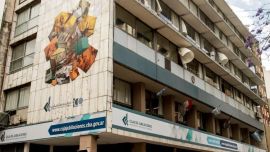The national government has officially confirmed the return of the so-called 'soy dollar' (Dólar Soja) scheme to boost exports and, in turn, foreign currency incomings.
Confirming the launch of a fifth "Export Increase Programme," the Economy Ministry said Tuesday that it was acting amid a lack of foreign currency but an imbalance in foreign trade.
The policy, announced through Decree 443/2023, published in the Official Gazette, is the fifth incarnation of the government scheme, this time aimed at soy producers, specifically exporters who have traded the crop abroad in the last 18 months. They will be rewarded if they liquidate sales before September 30, a few weeks before the presidential election.
The decree specified that, unlike previous schemes, this new version will not have a fixed and differential exchange rate. In this sense, 75 percent of the countervalue of the export of goods will have to be brought in via foreign currency and negotiated through the Free Exchange Market, while the remaining 25 percent will be "freely available" to exporters.
In other words, farmers will be able to buy a tonne of soya by paying 75 percent at an official exchange rate (365 pesos per greenback now), while the remaining percentage can be bought through a free exchange rate (for example, the MEP or CCL dollar, currently at 672 and 769 pesos, respectively).
The government justified the measure by stating that "it is necessary to continue implementing policies that tend to strengthen the reserves of the Central Bank, stimulating the generation of genuine income for the National State, as a result of the export of goods with low incidence in the national supply value chains."
In the decree's remarks, the government pointed out that Argentina is "a relevant world exporter of soybean manufactures, products with low direct impact on the national supply chain" and established that one of the objectives of this is "that food and raw materials do not have a direct impact on the family basket or on the monthly inflation index measurements."
This latter aspect is key given that private consultancy firms expect inflation to soar to double digits following the recent devaluation of the peso.
The Argentine Rural Society questioned the new measure, arguing that it "does not guarantee anything to farmers."
"The publication of the decree ratifies that the implementation of these announcements are a benefit for the government and the industry, not guaranteeing nothing to producers," the organisation said in a statement.
In addition, it insisted that the Argentine economy "needs to have a single exchange rate, without restrictions or export duties."
The fourth edition of the Export Increase Programme (PIE) offered a special exchange rate at 340 pesos per dollar, which applied to items from regional economies, corn, barley and rye. Effective until August 31, its goal was to raise some US$2 billion, a target it exceeded in just a few days, reaching a total of US$2.126 billion.
– TIMES/PERFIL/NA























Comments